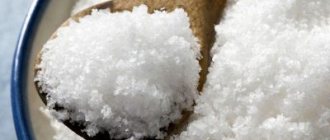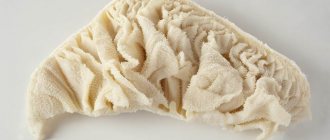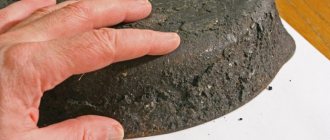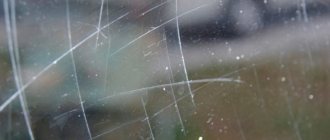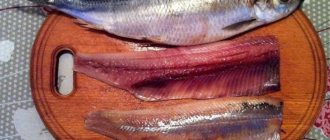It is impossible to imagine a cozy home without light and airy tulle on the windows. But even the most luxurious accessory will look unattractive if it is covered with dust or stains. Therefore, every housewife should know how to wash tulle at home so that it shines clean and fresh. In this article we will talk about the rules for washing weightless fabric in an automatic machine and proven methods for bleaching snow-white tulle curtains.
Pure tulle will decorate any room
How to bleach tulle from gray and yellowness at home
The gradual transformation of white air curtains on the windows into gray-yellow and untidy in appearance as a result of exposure to sunlight, dust, smoke, the appearance of stains from grease and other similar contaminants on the curtains is a common problem. But the situation can be corrected using different approaches.
Salt
Salt is always at hand, so it can be called the number one remedy for whitening tulle, and it has been used for decades for this purpose.
- To bleach curtains with salt, you need to dissolve it in warm water. It is better to take coarse salt, but if this is not available, use fine salt. The concentration required for the procedure is achieved with two level tablespoons dissolved in a liter of warm water. The concentration may be higher if it is necessary to bleach very dirty tulle.
- You can immediately pour powder suitable for washing curtains into the same solution, or you can do this a second time after soaking them in a salt solution.
- Immerse the tulle curtains completely in the resulting solution and leave them for a couple of hours or more.
- For a better effect, the tulle is periodically removed from the solution, turned over and lowered again.
- After this, the curtains are washed by hand or in a washing machine.
Ammonia
To bleach yellowed or overly dirty nylon curtains, a ten percent ammonia solution in combination with hydrogen peroxide is used.
- A solution is prepared from one tablespoon of ammonia, two tablespoons of peroxide and 7 liters of warm water.
- Immerse clean tulle, washed in the usual way, into the composition for 30 minutes or a little more.
- The tulle is removed and rinsed.
Zelenka
Usually this product is used as an antiseptic, and not even in all countries of the world. Most likely, many countries around the world don’t even know about the use of brilliant green in the process of washing curtains and other white items. But housewives in the USSR knew this very well and often used this product to give white things a bluish-emerald tint. Just white things became bright white and pleasing to the eye.
- To do this, the tulle is first soaked for several hours in a soap solution.
- Then it is washed in the usual way by hand or in the washing machine.
- The brilliant green is connected already at the rinsing stage.
- A solution is prepared (it can be prepared while soaking the tulle or in advance) from three tablespoons of salt (without a slide), a few drops of brilliant green (5-7 drops are enough) and a glass of warm water. First, the salt is ground with an antiseptic, and then added to the water and stirred. The composition is left until completely dissolved, mixed again and filtered. The finished solution without sediment is added to the rinsing water. It is better to take a larger container for this.
- Washed curtains are placed in this water and rinsed on different sides.
With the help of greenery you can not only brighten up new curtains, but also practically revive old and yellowed ones.
Blue
The principle of action of blue is the same as that of green. Rather, it does not completely whiten, but masks the yellowness, making the fabric snow-white with a bluish tint. Blue is used only in the process of rinsing things.
- The washed curtains are placed in a large container with the prepared composition.
- The solution is prepared either from a powder or liquid.
- For 10 liters of cool water, take half a teaspoon of powder or 1 cap of liquid blue, mix everything well. In the case of powder, it is better to strain the resulting mixture.
- The tulle is rinsed in blue water and hung without spinning. After the procedure, you can rinse again in clean water.
You can turn curtains blue in an express way: in an automatic washing machine.
- First, tulle curtains are washed on a delicate cycle.
- 1 cap of blue is poured into the conditioner compartment and the rinse mode is started. Blue can be added immediately during the washing process by running an additional rinse after that.
Boric acid
Boric acid powder or alcohol solution can be used to bleach white items, including tulle curtains.
Before washing, curtains are soaked in the composition (10 grams or 1 tablespoon of alcohol solution per liter of water) for an hour and a half, and then washed as usual.
The indicated concentration is suitable for cotton and linen tulle; for synthetic tulle, the dosage is halved.
Laundry soap
Soap effectively fights old stains, yellowness and grayness. It can restore the whiteness of old curtains and give them new life.
- You need to grate a piece of laundry soap on a coarse grater. Pour the resulting crumbs into an enamel bowl with water heated to 60-70 degrees, bring to a boil, stirring, and remove from heat.
- Cool the mixture to 40 degrees and place the curtains in it. Stains can also be additionally rubbed with soap.
- Leave for a couple of hours.
- After soaking, wash the stains by hand.
- Next, we wash the tulle either in the machine or by hand.
Starch
Typically, starch is used to stiffen cotton and linen materials. For example, starched white napkins always look beautiful and can be used to decorate a house in a rustic style and its varieties: Provence and country. Starch will also help restore the snow-white color of tulle cotton or linen curtains.
- Curtains are first washed with powder.
- Dissolve one glass of starch in a glass of warm water.
- The resulting mixture is poured into a large basin of water. The indicated amount of product is calculated for 10 liters of water. If the curtains are large, then the dosage needs to be increased.
- Soak the tulle for several hours (5-6 hours are enough to bleach the tulle).
- Rinse.
Digestion
An unjustifiably forgotten “old-fashioned” method with which you can wash tulle so that it is snow-white.
Very dirty curtains are first soaked and washed in any powder and rinsed.
- Take an enameled or zinc tank, a large saucepan or basin, pour water (about half the capacity).
- Grated laundry soap or bleach, for example, Persol, dissolves in water. You can also use other means for boiling: any other type of powder or bleach, salt, soda, peroxide, potassium permanganate and others. But it is not recommended to use chlorine-containing products for this procedure, since chlorine compounds that are harmful to health will be released during boiling. In any case, it is better to open the windows during the manipulations.
- The curtains are placed in a prepared container with washing components and boiled with periodic stirring with wooden tongs for an hour.
- The time can be increased to two hours if it is not possible to wash the tulle until it is white within an hour.
It is important to remember that only materials made from natural fibers can be boiled. If you have doubts about the composition of the fabric, then it is better not to use this method, but to look for another solution on how to whiten curtains.
Soda
Tulle can also be bleached using baking soda. This is done before washing.
Warm water is poured into a basin or bucket, a glass of soda is poured in, and stirred.
The curtains are soaked for 2-3 hours and then washed.
How to bleach tulle with soda - video
Lemon acid
Acids promote the breakdown of fats and help remove stubborn stains from fabrics.
Citric acid is used after washing.
Place washed curtains in the solution. The mixture is prepared from a packet of the substance weighing 25 grams for every 2 liters of water. The tulle is in the solution for about half an hour, and then rinsed.
How to bleach tulle with potassium permanganate
Potassium permanganate is one of the means that can be used to whiten yellowed curtains.
- To do this, potassium permanganate crystals are diluted in water until a dark pink color is obtained.
- The mixture is poured into a basin.
- Tulle is placed in the basin for about 30 minutes.
- Washing is carried out after soaking in the usual way.
We use blue
Surely every housewife has used a blue solution at least once. It is a bright blue liquid, a small amount of which gives the fabric a bluish tint.
- Blue and brilliant green solution work on the same principle. Coloring pigments penetrate into synthetic fibers in small quantities, thereby dulling the gray and yellow color.
- The curtain must first be soaked in warm liquid with a small amount of washing powder. Soap particles help quickly remove dirt and dust particles.
- After this, the fabric needs to be thoroughly rinsed. If you neglect this requirement, then the blue pigment will lie unevenly on the surface of the tulle. As a result, after drying, streaks and large spots of bright color will appear on the surface of the fabric.
To add freshness, you will need 10 drops per 5 liters of water. Some blue formulations may contain lumps or flakes. First, mix the bright liquid thoroughly in water until it is completely dissolved.
Place the product for two minutes while actively rinsing. The fabric in the container must be actively mixed so that the shade is evenly distributed throughout the fiber structure.
Special products for washing tulle
Curtains can be put in order not only with the help of home remedies, but also with the help of special purchased ones. The best products that return curtains to their original appearance:
FRAU SCHMIDT SUPER WHITE TULLE
"Super White Tulle" is a bleaching agent in the form of tablets that enhances the effect of the powder, designed specifically to restore the snow-whiteness of curtains. The instructions tell you how to bleach tulle with this product.
Directly into the drum of the washing machine you need to put the product at the rate of 1 tablet for the maximum drum load of three kilograms. Accordingly, if the drum load is 6 kilograms or more, then you need to put 2 tablets.
The curtains are placed in the drum and the washing powder is placed in the detergent dispenser. The amount of powder is taken in accordance with the recommendations of its manufacturer.
Curtains are washed at a temperature of 30 degrees in the “delicate”, “curtain washing” and similar modes. If necessary, you can turn on an additional rinse. Using Frau Schmidt's product is a quick way to restore them to a decent appearance and their former cleanliness.
SPLASH FOR TULLE FROM GENERAL FRESH
Another special product produced by the Polish company General Fresh, “Splash-bleach for tulle,” will help in solving the question of “how to wash tulle from grayness.” This bleach can be used both during hand washing and during machine washing. After washing the curtains by hand, you need to lower them several times into a container of water in which 30 grams of bleach have previously been dissolved.
When machine washing, the manufacturer recommends adding the product during the last rinse. Not all machine models have the option of adding the product during washing or during the last rinse, so it is more advisable to add the product after the cycle is completed and start rinsing.
Reviews for this product are positive. Everyone who used Splash noted that the desired effect was achieved without much time or physical effort.
Elixir for tulle and curtains “CASHMERE”
A bleach with similar properties and composition, including optical brightener, as the previously listed special products.
“Cashmere” is intended for bleaching specifically various tulles, curtains, curtains, especially kitchen ones. It can be used for soaking and hand washing (add 10-15 grams of product per 10 liters of water), as well as in washing machines (add 90 to 110 grams for every 2-2.5 kilograms of dry laundry).
The manufacturer not only placed recommendations on the use of this product on the packaging, he also placed some useful tips on washing rules, for example, washing temperature conditions.
Basic rules for washing in a machine
How should tulle be washed in a washing machine to make it snow-white? Let's look at the general rules.
- Using a special bag. Tulle is usually very light and translucent. It can be damaged by other laundry or metal parts of the machine. For this reason, a protective bag must always be used.
Note! You can replace the special bag with a regular white pillowcase. The main thing is that it must be clean.
- It is necessary to set the temperature only based on the type of fabric. Nylon, organza, chiffon can withstand temperatures no higher than thirty degrees. Cotton can be processed in water at sixty degrees.
A temperature of 30 degrees should also be chosen if you do not know the composition of the fabric - There must be a compelling reason to add home remedies. Don't experiment. If allowed, it is better to buy a chemical detergent for delicate washing.
An important advantage of special products for delicate washing is low temperature conditions. - The spin should be minimal - 400-500 rpm. Higher speeds will wear out the matter.
- To bleach fabric, in some cases you can use bleach, in others - soaking with peroxide, soda, blue, or brilliant green. You can choose the right method only if you take into account the type of matter. It is better to soak curtains that are too delicate and fragile using folk remedies. Bleach is sometimes allowed to be used on cotton fabrics.
It has been noticed that pharmaceutical greens work well when paired with salt. 10 drops of brilliant green and 2 tbsp. spoons of salt are diluted in a glass of water, then poured into a basin and after complete dissolution, soak the tulle
Washing tulle in different ways
Curtains can be washed by hand or using a washing machine. When washing by hand, it is recommended to soak the curtains.
Pre-soak
- The container is prepared, water is poured at a temperature of 40 degrees.
- The selected detergent is dissolved in water: washing powder, grated laundry soap or other product.
- Tulle is placed in the solution for several hours.
Handwash
- After soaking, the curtains are removed from the dirty water and rinsed once to get rid of the soaking agent and dirt.
- A composition for washing is made. For this purpose, washing powders, laundry soap, bleaches and hot water are used. The water temperature for synthetics, wool or silk can be no higher than 30 degrees, for mixed fabrics no higher than 40 degrees (the percentage of threads in the composition is taken into account), and for cotton and linen it can be about 50 degrees.
- The curtains are placed in the container for a few minutes. After this, the canvas can be wrinkled a little, periodically pulling it out and immersing it in water again.
- The washed curtains are taken out and hung on a rope.
- Clean water is poured in, in which the same thing is done with the curtains as in the previous paragraph. Rinsing is carried out until clean water is obtained in two or more waters.
- Curtains are hung unwrung.
It is better to carry out all manipulations with gloves.
How to wash tulle in an automatic washing machine
Before washing the curtains in the machine, they are prepared for bleaching.
To do this, the curtains are first rinsed in warm water without detergents, then soaked in detergents to most effectively remove stubborn dirt.
The choice of detergent depends on the composition of the fabric, the degree of its contamination, as well as financial capabilities. If you have the opportunity to buy expensive bleaches and special powders for tulle, then you can purchase them.
If this is not possible, then you should not be upset; you can also use some inexpensive home remedies for washing in a machine. In the machine you can perfectly bleach tulle with salt and soda. To do this, a mixture of powder and salt, powder and soda, or three components together is placed in the powder tray. The volume of the mixture should be the same as when washing with powder.
In addition, it is important to determine which mode to use for washing curtains. If the machine has a special mode “for washing curtains,” then it is better to choose it, since it provides all the parameters: temperature, drum rotation speed, spin delicacy or lack thereof. If there is no such mode, then you should set the minimum temperature to 30 degrees (for cotton fabrics you can increase it to 40), the minimum drum rotation speed and delicate spin (or turn it off altogether if the fabric is very delicate).
Curtains are placed neatly folded in the drum, and thinner curtains are placed in cotton bags. After completing the program, the curtains are removed, slightly shaken and immediately hung on the curtain rod. If they are too damp and water is flowing from them, then they need to be hung on a rope in a straightened form.
Washing precautions
In order for tulle to delight you with freshness longer, you need to properly care for it:
- Remove stains taking into account the properties of the material.
- Before washing, clean curtains from dust and soak them with powder.
- Do not wash with other items.
- Carefully place in a tank or basin.
- Do not wash in too hot water unless permitted.
- Wash delicate materials in special bags.
- Avoid machine spinning and twisting.
- To enhance the color of painted curtains, it is recommended to do the last rinse with a couple of tablespoons of vinegar.
The listed tips have been tested by housewives more than once. Thanks to them, washing the tulle will give the desired result and preserve the fresh appearance and beauty of the curtain.
How to properly wash tulle from different materials
Each type of material requires an individual approach, and thin, delicate materials require special attention and treatment, and only in this case will they continue to decorate the house and delight for a long time.
How to bleach nylon tulle
Nylon is a very durable material. Curtains made from it serve for a long time, do not lose their shape, but over time they lose their original color, fading, turning yellow and gray. But you can bleach nylon curtains with various means, both homemade and purchased.
Curtains made of nylon threads bleach perfectly:
- salt (in a solution of 3 level tablespoons and 10 liters of water you need to keep the curtains for about four hours),
- starch (after washing, the curtains are placed for half an hour in a mixture of a glass of starch and a bucket of water),
- refreshed with blue (kept in water, blued with one cap of the product for an hour) and green (the same as in the case of blue, kept for some time in 10 liters of water in which brilliant green was dissolved in a dosage of no more than 10 drops per 250 milliliters liquids).
Oxygen-containing bleaches are suitable from commercial products.
Acetone and alkaline substances should not be used to remove stains, as they can dissolve nylon threads.
It is also not recommended to use chlorine-containing bleaches and acids; they have an aggressive effect on nylon.
The maximum ironing temperature for nylon fabrics is 110 degrees, but washing is carried out at a temperature no higher than 40.
How to wash organza tulle
Although organza is a delicate fabric made from viscose or silk, some bleaching agents can be used on it. Organza curtains are soaked before washing in water with a few drops of ammonia, in a solution of water with starch or in salt water (salt concentration 40 grams per 5 liters of liquid). After this, the curtains are washed with regular powder or a special product for tulle, for example, Splash or Cashmere.
Washing tulle from a voile
A light and airy veil requires a reverent attitude. Soaked and washed only in liquid detergents without pressing, twisting or putting pressure on the material. You can wash by hand or in a machine in delicate wash mode at 30 degrees without spinning. Before loading into the drum, it can be placed in a bag. You can bleach curtains made from this noble fabric in water to which 2 parts peroxide and 1 part ammonia are added. You can also use salt, bluing and laundry soap.
How to wash white chiffon tulle
It is better to wash white chiffon tulle by hand in warm water using liquid detergents. Curtains do not need to be squeezed, twisted or aggressively wrinkled. You can bleach with the same substances as the veil: peroxide, ammonia, salt.
Kiseya
Original decorative curtains made of threads must be washed very carefully to avoid tangling. First they need to be braided, then removed and placed in a bag. Place in a container of water to which liquid detergent has been added. Next, wash it carefully. Rinse the same way. Remove from the water, hang to drain, hang in place, unbraid and leave to dry.
Jacquard
Jacquard curtains with an intricate pattern, due to the special weave of the threads, can be made from different fibers, so the exposure temperature may vary. This point needs to be clarified on the label. Caring for such curtains depends on the composition of the fabric and is generally no different from other types of curtains, but there is one subtlety: it is important to take care of the design. It can become deformed from aggressive influence. Therefore, jacquard tulle does not need to be wrung out either during hand washing or during machine washing.
The use of chlorine bleaches is not recommended. It is better to use liquid detergents for washing.
Tulle mesh
The mesh is made from different fibers, so you need to know the exact composition. But the general rules for washing mesh curtains are as follows: they cannot be washed in a machine, they can only be washed by hand, despite the fact that they are quite strong and wear-resistant. Before washing, curtains should be soaked in a soapy solution, to which you can also add salt or soda. You can wash them in regular powder, but it is better to wash them in a liquid detergent or pre-dissolve the powder.
How to starch curtains: do it quickly, efficiently
Significantly prolong the purity of the product, bring a feeling of celebration into the house, give clarity to the design - all this can be done with the help of ordinary starch. Starching makes the material stronger and denser. With this procedure, the canvas holds its shape longer, does not wrinkle, and gets dirty less. How to starch tulle? Let's look at the process step by step.
A starched curtain looks fresh, elegant and festive
Preparation
Before the procedure itself, the curtain must be prepared: washed, bleached. To do this, you should use approved home or chemical remedies.
You can wash tulle by hand or in a machine, it all depends on the type of fabric
Selecting a processing method
There are three options:
- The soft way.
- Average.
- Hard.
Each method requires its own amount of starch. A soft method is suitable for processing tulles. To do this, you need to prepare one teaspoon of starch, a liter of warm water.
It makes no difference what kind of starch you use, but corn starch is much softer than potato starch and dissolves better in cold water
Soaking in solution
This is the last stage. To prepare the solution, place only one teaspoon of starch in a liter of warm water.
It is important to brew starch in the correct proportion
The liquid must be boiled until a paste forms. After this, it needs to be given time to cool and strain thoroughly. The cold solution should be poured into a basin, and a curtain should be placed there. Soak should be about thirty minutes. Afterwards the tulle can be taken out and dried.
After soaking in a starch solution, do not twist the tulle, but simply shake it and hang it to dry well straightened.
Rules for drying and ironing
Curtains are always visible and should look impeccable. Therefore, in addition to proper washing, they need to be properly dried and ironed.
- To prevent curtains from becoming wrinkled during washing, they do not need to be twisted or wrung out strongly, and some types of fabrics cannot be wrung out at all.
- It is better to take them out of the water wet so that they dry naturally.
- After the water has drained a little, the curtains can be hung directly on the curtain rod if the fabric is wrinkle-resistant.
- If the fabric usually looks wrinkled after drying, then such curtains must first be dried and then ironed.
- They are dried flat out so that they are not exposed to direct sunlight.
It is better to iron curtains slightly damp on the reverse side on a flat surface, choosing the right temperature.
You need to start from the top, moving the canvas away from you. If necessary, you can use steam. It is better to iron decorative elements through gauze. If the fabric is heavily wrinkled, then wrinkles may immediately appear on it, so it is better to place the ironed part on a table moved towards the board or on chairs.
Keeping your home clean is part of taking care of your health.
A special element of home interior decor is tulle. White and colored, translucent, airy, smooth and patterned. The name tulle received in honor of one
of a new French city. Over time, many new materials and design solutions have appeared, but housewives prefer tulle. This fabric guarantees a free exchange of energy between the interior of the house and the external environment. The perfection of style and creative concept is emphasized by curtains, drapes and drapes. Our home is a living organism. Therefore, cleanliness is important to maintain a healthy atmosphere, mood and well-being. Keeping your home clean is part of taking care of your health. A tidy house is a center of comfort and warmth.
Snow-white tulle in the interior
Over time, snow-white products become gray, dull and dusty, acquire a yellowish tint, and fade. Dust settles on textile fabrics and stains appear. Regular care will remove unwanted dust, and washing will help remove dirt, return the canvases to an attractive appearance, restore freshness, and preserve the splendor of the products. This is not difficult to do, by observing the subtleties of keeping the house clean, you are showing sincere concern for the health of the inhabitants.
How to bleach old yellowed tulle
To bleach old curtains that are too dirty, you need to select a method depending on the type of fabric.
If the fabric is made of natural fibers, then boiling is suitable for bleaching. The curtains are first soaked in a solution of laundry soap for several hours. The dirtiest places are additionally soaped. Various substances are also suitable for soaking before washing: salt, soda, boric acid, potassium permanganate.
The main wash can be done twice, changing the water. Powders, bleaches, salt, soda and their combinations are used for washing. After washing, the result is fixed with one of the following agents: starch, brilliant green, blue, ammonia, peroxide or citric acid. After exposure to the composition of these substances, the curtains are rinsed. One such cycle should be enough to return the tulle to a decent appearance.
What is tulle
Thin translucent material began to be produced on an industrial scale in France (in the city of Tulle) back in the 15th century. It is made on special machines from two or three thread systems. Tulle can be of different colors, plain or variegated.
Gossamer tulle with embroidery
Recently, the use of 3D printing has become popular.
3D printing
3D printing on tulle
Smooth and patterned fabrics are used in the manufacture of clothing and linen. The material is no less common as a decoration for window openings. Light curtains can act as an independent design element or in combination with thicker curtains and lambrequins.
Curtains and tulle
Tulle curtains serve not only to decorate the interior. They also perform utilitarian functions: they protect the room from sunlight and air currents when the windows are open, and allow you to protect those living in an apartment or house from prying eyes. The latter circumstance gave impetus to the development of matter production. The thing is that the structure of the fabric allows those in the room to observe what is happening on the street, while they are not visible from the outside.
Depending on the weaving method, several types of material are available. Organza, muslin, silk, muslin and veil are most often used to decorate window openings.
Tulle: types
In the production of tulle, threads from natural or synthetic fibers are used. It is the use of polyamide (nylon and nylon), polyester and polypropylene raw materials that makes the finished product cheaper and gives it better performance characteristics.
Nylon tulle
For those who gravitate towards using natural materials when decorating premises, it is possible to purchase curtains made of linen or cotton, but made with a small addition of synthetics, which increases their functionality: wear resistance, the ability to repel dust, resistance to sunlight, greater elasticity (linen materials after washing they do not behave in the best way: they wrinkle a lot and can shrink).
Linen tulle
Cotton
Thanks to the addition of synthetic compounds, it is also possible to improve the decorative properties of the material, for example, to add shine.
During use, any fabric loses its original attractive external characteristics. This largely depends on the place where the curtains are hung. Of course, the curtains decorating the windows in the kitchen get dirty much faster than those hanging in other rooms.
Tulle for the kitchen
The location of the living space also plays a role. If the windows face a busy highway, the likelihood of the tulle acquiring a gray tint increases significantly.
To make a room look attractive and cozy, textiles need to be taken care of. If previously the only way to restore the snow-whiteness of curtains was to boil them on the stove in a large container, now there are other, more convenient and faster ways to keep curtains in a tidy condition. Although some folk secrets that have come down to us from our ancestors should not be discounted.
How to remove stains from tulle
In addition to yellowness and gray tint, various spots may appear on the tulle. When removing any stains, it is necessary to take into account the composition of the fabric, and after getting rid of dirt in any way, the tulle must be washed and rinsed.
Rust
To remove rust stains on curtains, you can use citric acid, toothpaste, chalk and other means.
A piece of fabric with rust is immersed in a hot solution of a glass of water and a tablespoon of lemon juice for a short time.
Rub the stain with toothpaste using a brush, and leave the paste for a day. Suitable for thin and mesh fabrics such as organza, mesh, veil.
A mixture of glycerin, chalk and water in equal volume is applied to the stain for 24 hours. It is used on nylon and other fabrics to which acids cannot be used.
Fat
Laundry soap, ammonia, glycerin, vinegar, and salt work well with greasy stains.
About two teaspoons of ammonia are poured into a glass of soap solution. The mixture is applied to the stain; it can be rubbed with a small brush.
Ammonia can be mixed with glycerin. In this case, 2 tablespoons of water and a tablespoon of glycerin are added to two teaspoons of ammonia.
If you add a tablespoon of salt and 4 tablespoons of vinegar to four teaspoons of ammonia, then with this composition you can get rid of old grease stains.
How to wash kitchen tulle from greasy stains
Mold
Chlorine removes mold stains well. If the composition of the fabric allows, you can use bleach with chlorine. But not all curtain fabrics allow this.
Pre-washed tulle should be placed in an empty basin. Pour table vinegar onto the mold stain and leave for a couple of hours. The time can be extended if the result is not visible, and instead of vinegar, use citric acid diluted in water or lemon juice.
This method is not suitable for nylon. You can try to get rid of mold from nylon curtains using salt, soda, laundry soap or ammonia.
How does starch affect whitening?
You can get rid of yellowed and gray curtains using one component that housewives always have. We're talking about potato starch.
To do this, you need to follow some steps:
- The tulle is first soaked in warm water with a small amount of detergent;
- Next, after rinsing, place the fabric in a container with cool water. Add 300 grams of starch here. Experts recommend first diluting the dry powder in a separate container so that large particles do not form lumps on the surface of the synthetic product;
- Soak the curtains for 7 hours;
After this, we wring out the product by hand and immediately hang it on the ledge. This way the tulle will take the desired shape and characteristic snow-white shade.
How not to ruin tulle
So that in pursuit of the idea called “how to make tulle snow-white”, you do not suffer disappointment due to spoiled favorite curtains, you need to remember some rules.
- During the soaking and washing process, tulle comes into contact with various agents that can be aggressive to some types of fabric. Therefore, before deciding how to bleach the tulle, you need to study the information about the composition and the manufacturer’s recommendations on the label.
- Curtains made from artificial fibers should not be exposed to high temperatures, and only fabrics made from natural fibers (cotton and linen) can be boiled.
- If you use purchased detergents for washing, you should strictly follow the instructions written on the packaging.
- If the curtain is bleached using powdered folk remedies, then after dilution it is better to strain the resulting mixtures so that no stains remain on the fabric.
- When using any substances for bleaching, you must strictly observe their dosage and time of exposure to the material.
- Curtains are washed in machines on delicate cycles, and during hand washing they are not twisted and hung damp.
If you follow these simple rules, the tulle will never deteriorate.
General rules
- Before washing, be sure to find out the type of fabric and follow the specific recommendations for it.
Study the label on the material, which indicates the washing temperature and the possibility of using chemical bleaches - It is better to take expensive curtains to dry cleaning immediately. It doesn't cost that much.
- The material should not be cleaned too often. Only as needed - when dust accumulates, flames will appear.
Dry cleaning is always less harmful to any fabric than washing. Therefore, it is better to vacuum curtains more often than to wash them.
Techniques for cleaning curtains and tulle
Airing is a simple and accessible method for cleaning and cleaning textiles. Opening a window or door for a while will saturate the atmosphere of the house with energy and the scent of cleanliness. Heavy _
It’s good to shake out old curtains outside.
Cleaning with a vacuum cleaner is suitable for curtains made of thick material. Use a special attachment for this so as not to spoil the fabric .
with a stiff brush.
If the vacuum cleaner does not come with an attachment, wrap a thin cloth around the brush and
secure it with an elastic band. Remember, you also need to clean the window side of the curtains. Frequency: twice a month.
But over time, curtains and tulle products can only be restored to their fresh appearance and whiteness by washing . It is impossible to unequivocally answer the question about the frequency of washing: in the kitchen and in houses located on streets with busy traffic, you need to wash often, where there is less dust - 2-3 times a year.
Machine washable features
Household appliances of our time make the work of a housewife easier. Cleaning, brightening, and stain removal are performed by machines instead of humans. When choosing this method of maintaining cleanliness, use the following recommendations:
- Take care of the delicate wash cycle. Neatly folded fabric, placed in a laundry bag or white cotton pillowcase. Such packaging will prevent fraying of the edges and tearing of thin elements;
- It is preferable to use liquid detergent or concentrated special detergents for washing curtains and tulle;
- Do not use substances containing chlorine;
- Oxygen-containing bleach is a universal preparation that preserves fabric. We buy, read the manual and use it with confidence;
- You can add 2 tablespoons of salt into the compartment along with the washing powder. This will help lighten the fabric during the washing stage;
- Tulle bleaching is also possible using 10 tablets of hydrogen peroxide (pour the powder into the washing machine compartment and set the gentle wash mode);
- For spinning, select the minimum number of revolutions.
If you doubt the safety of washing, it is better to entrust the cleaning to professionals.
Modern automatic machines can significantly facilitate the housewife’s work
What to do if tulle fabric shrinks after washing
Items made from natural materials are most prone to shrinkage. As a rule, this is a consequence of high temperature or the wrong choice of cleaning agents. Linen and cotton, as representatives of natural fabrics, are at risk. Shrinkage and shrinkage occur due to incorrect temperature conditions or incorrect choice of washing agent. Therefore, carefully read the instructions first and take into account the restrictions on use. If trouble does occur, ordinary hydrogen peroxide will help correct the situation: dilute 20–30 ml of the drug in 10 liters of cold water. Thoroughly rinse the shrunken item in the solution, while actively straightening the deformed areas. Rinsing with conditioner is also an effective technique.
